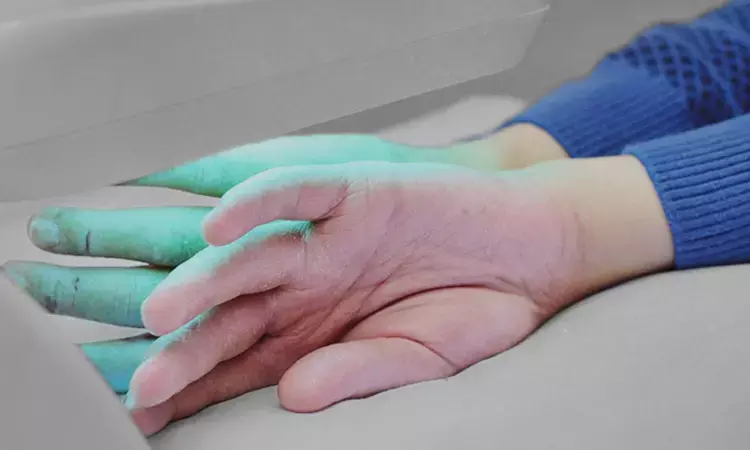- Home
- Medical news & Guidelines
- Anesthesiology
- Cardiology and CTVS
- Critical Care
- Dentistry
- Dermatology
- Diabetes and Endocrinology
- ENT
- Gastroenterology
- Medicine
- Nephrology
- Neurology
- Obstretics-Gynaecology
- Oncology
- Ophthalmology
- Orthopaedics
- Pediatrics-Neonatology
- Psychiatry
- Pulmonology
- Radiology
- Surgery
- Urology
- Laboratory Medicine
- Diet
- Nursing
- Paramedical
- Physiotherapy
- Health news
- Fact Check
- Bone Health Fact Check
- Brain Health Fact Check
- Cancer Related Fact Check
- Child Care Fact Check
- Dental and oral health fact check
- Diabetes and metabolic health fact check
- Diet and Nutrition Fact Check
- Eye and ENT Care Fact Check
- Fitness fact check
- Gut health fact check
- Heart health fact check
- Kidney health fact check
- Medical education fact check
- Men's health fact check
- Respiratory fact check
- Skin and hair care fact check
- Vaccine and Immunization fact check
- Women's health fact check
- AYUSH
- State News
- Andaman and Nicobar Islands
- Andhra Pradesh
- Arunachal Pradesh
- Assam
- Bihar
- Chandigarh
- Chattisgarh
- Dadra and Nagar Haveli
- Daman and Diu
- Delhi
- Goa
- Gujarat
- Haryana
- Himachal Pradesh
- Jammu & Kashmir
- Jharkhand
- Karnataka
- Kerala
- Ladakh
- Lakshadweep
- Madhya Pradesh
- Maharashtra
- Manipur
- Meghalaya
- Mizoram
- Nagaland
- Odisha
- Puducherry
- Punjab
- Rajasthan
- Sikkim
- Tamil Nadu
- Telangana
- Tripura
- Uttar Pradesh
- Uttrakhand
- West Bengal
- Medical Education
- Industry
Nb-UVB or PUVA, which phototherapy more effective for treating early Mycosis Fungoides?

Italy: A recent study published in Photodermatology Photoimmunology and Photomedicine provides valuable insights into phototherapy use in early mycosis fungoides (MF).
The study found that psoralen UVA (PUVA) and narrow band-nb UVB have similar efficacy for treating early-stage mycosis fungoides, and whole nb--UVB was found to have a historically better safety profile.
Sezary Syndrome and Mycosis fungoides (MF) are the most common forms of cutaneous T-cell lymphoma. Early-stage MF is known to have indolent behaviour; treatment with skin-directed therapies, such as phototherapy, is recommended instead of systemic therapies.
Phototherapy is a popular treatment option performed with two commonly used light sources -- narrow band-nb UVB and PUVA. The role of UVB is debatable. Due to its potential carcinogenic role, PUVA is used less commonly but has systemic effects, while nb-UVB has mostly skin-limited effects. In 2021, the Cutaneous Lymphoma Italian Study Group reached a consensus on technical schedules for NB-UVB and PUVA for MF.
Against the above background, Corrado Zengarini from the University of Bologna, Bologna, Italy, and colleagues aimed to analyze and compare the efficacy of the two phototherapy options for early-MF patients.
The study included patients diagnosed with IA/B Mycosis fungoides in the last ten years, who at least had follow-up data of 12 months and a minimum of 24 phototherapy sessions (PUVA or nb UVB) and treated with topical steroids apart from phototherapy. The study did not include patients who underwent systemic treatment (such as systemic steroids, acitretin, and bexarotene).
"Our data corroborate the literature on the efficacy of PUVA and nb-UVB. In particular, in the series, nb UVB showed a CR (complete response) rate of 71.7%, similar to previously reported," the authors wrote.
PUVA CR rate was 73.1%, similar to the literature data. According to the authors, the higher number of patients treated with nb-UVB shows the current trend to prefer nb-UVB to PUVA in early-stage patients. They suggest the absence of a higher CR rate in PUVA versus nb-UVB can be attributed to the small PUVA patient number.
"However, even if the complete and partial response rates are in percentage terms better in those treated with nb-UVB versus those treated with PUVA when the disease's stage stratifies them, emerges no significant differences underscoring that proportionally, the NB-UVB for stages IA seem to have an efficacy comparable to that of PUVA for stages 1B," the authors added.
The results showed that the two therapy options are equally effective for treating early MF, with no remarkable differences in clinical response, although PUVA was tied to more adverse effects.
"The study provides valuable insights into phototherapy use in early MF, and the findings can be used to guide treatment decisions and improve patient outcomes," the authors conclude.
Reference:
Zengarini C, Baruffaldi G, Piraccini BM, Bardazzi F, Mussi M, Hrvatin Stancic B, Pileri A. Nb-UVB and PUVA therapy in treating early stages of Mycosis Fungoides: A single-center cross-sectional study. Photodermatol Photoimmunol Photomed. 2023 Mar 27. doi: 10.1111/phpp.12873. Epub ahead of print. PMID: 36974002.
Dr Kamal Kant Kohli-MBBS, DTCD- a chest specialist with more than 30 years of practice and a flair for writing clinical articles, Dr Kamal Kant Kohli joined Medical Dialogues as a Chief Editor of Medical News. Besides writing articles, as an editor, he proofreads and verifies all the medical content published on Medical Dialogues including those coming from journals, studies,medical conferences,guidelines etc. Email: drkohli@medicaldialogues.in. Contact no. 011-43720751


